Review: Surface Go - part 3: Windows 10 - 'S mode' and Performance
Score:
75%
Following on from my Gallery of the Surface Go review hardware kit, the first part of my main review of this relevant ultra-mobile computing device, and part 2, concentrating on the Type Cover and the laptop experience, here's part 3, covering the particular 'S mode' default configuration of the Surface Go and comments on performance in daily use.
Buy Link | Download / Information Link

Is 'S mode' half-baked?
I should start by saying that no one should get hung up on 'Windows 10 in S mode' at the start. Whether the 'S' stands for Security or Store is also irrelevant, though the two functions are themselves very relevant. By default, out of the box, the Surface Go boots up in 'S mode', meaning that the on-device Store is the only way to install third party applications, i.e. applications which have been (hopefully) thoroughly checked by Microsoft. This has obvious huge knock on implications for improved 'Security', of course, since users aren't going to go downloading (either on purpose or after being tricked) random .EXEs from the Internet.
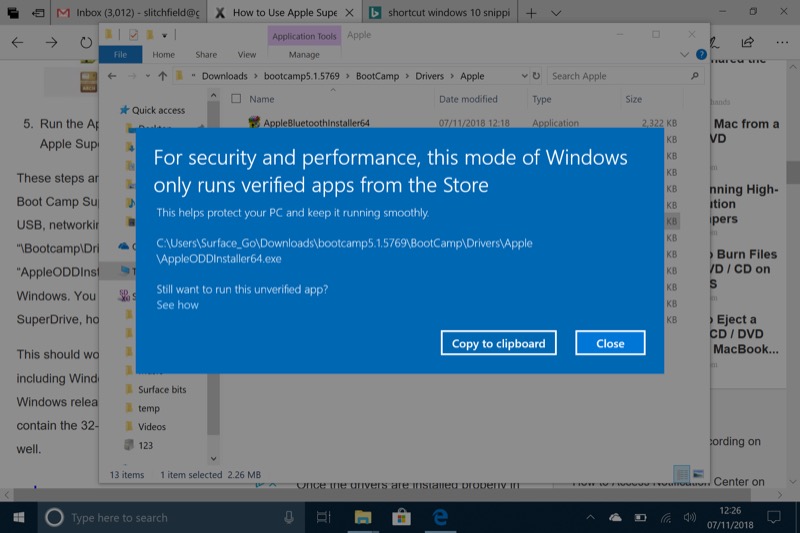
The S mode message that greets any attempt to install or run anything that wasn't sourced from the Store...
A typical use for such an 'S mode' then is in education or in a company - in both cases you want to keep kids/users more focussed on what they're supposed to be doing and also safe. And I absolutely applaud that 'S mode' is available. However, Microsoft is missing a trick or two for the 'rest of us'.
Because while it's free to 'switch' out of 'S mode' and back to full third party compatibility (Settings/Update & Security/Activation, then tap 'Go to Store' and then 'Get' the 'Switch out of S mode' hidden app), it's a one way street, i.e. you can't go back, and this makes little sense. I tried living within the 'S mode' restrictions for a week and then I had to install a driver to get a particular USB accessory working and this was immediately blocked. So I jumped through the aforementioned hoops to switch to the full Windows 10 (Home) status and the driver then went on OK. But there's no way to reverse this.
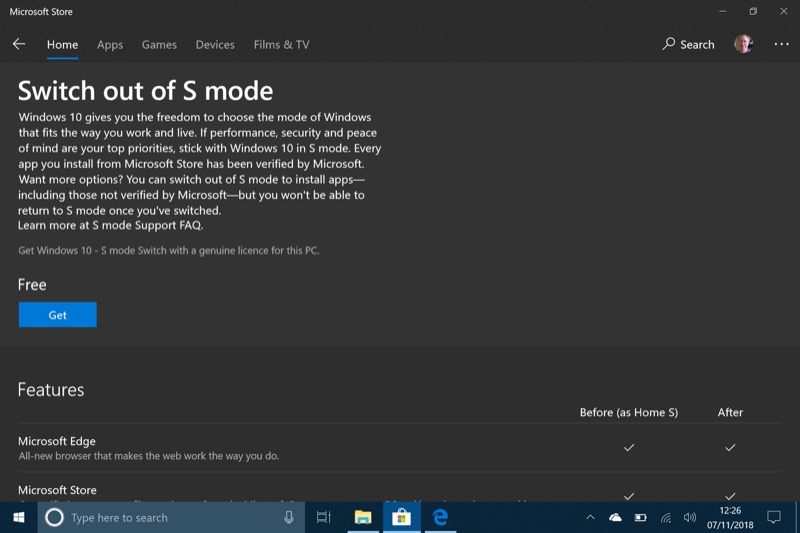
Don't go looking for this in the Store, but you get to this via Settings, it's a one time application to 'Get'...
It beggars belief how clunky this seems to be. [Update] As pointed out in the comments below, there's a 'Installing apps' setting in err.... 'Settings' in Windows 10 that also disallows application installs if not from the Store, and this feature is hidden from non-admins, making the whole 'S mode' thing even more (arguably) pointless.
Installing applications
With that rant out of the way, my Surface Go is therefore out of the 'S mode' app sandbox and behaves just as any full Windows 10 PC should - including, in my case, the installation of Nero Suite, my preferred Windows CD/DVD burner/copier and (even better) video editor. I've covered the previous version of Nero for Windows here and (like most app suites) it gets a wider scope every year. I've tried the Adobe, Pinnacle and Sony video editing apps in the past and Nero Video (in the suite here) is the one which requires the least resources and so edits and renders fastest on a PC which isn't top end. As here, with the Surface Go, of course.
Any standard Windows installer will now work. Though curiously, because so many applications (including iTunes, Spotify, Dropbox, etc.) are now in the Microsoft Store, apart from Nero, the only third party application that I've found necessary to 'side load' is - of course - the Chrome browser.
Why not Microsoft's Edge browser? A good question, I was perfectly fine using Edge for everything for a week or two. But I did start hitting small glitches - Disqus conversations that wouldn't load, odd layout artefacts. Signs that the modern web is built for, and tested against, Chrome first and foremost, and then Safari and Firefox next, with Edge a distant fourth. And, at some point, the question "Seeing as I'm no longer in Windows 10 S mode, why not give in and install and use Chrome?" kicks in.
Performance
Looking at Edge and Chrome on the Surface Go (again, 8GB RAM version) in terms of performance under Windows 10 branch 1803, the scores are all over the place, but they seem in the same ball park:
| Test/Browser |
Chrome | Edge |
| Basemark | 168.51 | 113.07 |
| Speedometer | 25.3 | 35.8 |
| Octane | 11430 | 12009 |
Using Edge in real life, it seems as speedy as Chrome (Disqus glitches, and all not withstanding), though I'd note that for both browsers, I experienced momentary lag when interacting with large web pages, even on this 8GB RAM machine. I put this down to the Pentium 4415Y chipset used, and I guess that's the main compromise that we hit when getting a full, touch-enabled, ultra-portable PC for £500 or so - don't expect lightning fast browsing. But still, working in a CMS, replying to Gmail, all seemed fine and the chipset never limited my use of the Surface Go.
Performance in general UWP and native Win32 applications was excellent - if you can live with slight delays in web browsers (seemingly the heaviest lifting most people need in 2018) then the rest of the PC experience is a doddle. From the aforementioned video editing to YouTube clients to dictionaries and other reference apps, from USB flashing utilities (for my phones) to the full version of Office, the Go never let me down for a second.
Obviously, I'm testing the higher specced Surface Go (8GB/128GB SSD). You can pay less and get 4GB/64GB (eMMC) or 4GB/128GB (SSD), and I haven't tested these, but an obvious question is how the lesser specced (and cheaper) versions fare. I think I can dismiss the 64GB eMMC variant for anything other than the locked down education and company uses. Not necessarily because of the disk speeds (eMMC is five times slower to read from than SSD) but because of the capacity. I've only had the Surface Go for a month and I'm up to 50GB used on its internal (C:) disk - if this had been a 64GB model then I'd be down to 14GB free and worried about always having to keep an eye on storage.
So 128GB it is. In terms of RAM, WindowsCentral had both models in and I'd agree with their conclusion here that 4GB is fine if the Surface Go is kept in 'S mode', so everything's more sanitised and approved. Once you break out into full Win32 territory then you're far more likely to start using software which will push 4GB RAM far too hard. So the aforementioned Chrome and Nero, but I'm sure you have your own favourite Win32 suite or utilities and these fit into the standard PC motto of 'the more RAM, the better'.
Unsurprisingly then, I'd recommend the configuration that I have here. It's roughly £130 more than the most basic model, but absolutely worth it for trouble-free ultra-mobile computing going forwards.
Windows 10 branches
Of note is that branch 1809 (a.k.a. the 'October 2018 Update') is still nowhere to be seen on the Surface Go. Obviously there's a rollout happening across PCs worldwide and I know that there were a couple of pauses to this rollout while bugs were fixed (famously one where user folders got deleted), but I was under the impression that all lights were green again for 1809. Oh well, I'm sure it will hit before this review series finishes and I'll report on it in my final verdict.
In case you're not up to speed on desktop Windows, 1803 (currently on the Go, the unimaginatively named 'April 2018 Update'!) added the concept of Timeline, letting you browse through recent documents and online URLs in one flow, to more quickly resume something, plus Nearby Sharing (Microsoft's equivalent to Apple's AirDrop), letting you move files between Windows 10 PCs (though not phones) via Bluetooth and Wifi, and Focus Assist, a fancier way of setting Do Not Disturb quickly in order to get something done without interruptions. Plus lots of tweaks to the Edge browser and Ink/Mixed Reality, which I won't go into in depth in this review.

'Timeline' syncs across devices, showing what you've been doing (see the control icon at the centre, bottom), though access from Windows 10 Mobile is minimal, note. Sadly.
Branch 1809, the one I'm waiting for (not quite with baited breath, but hey, newer is usually better!), delivers 'Your Phone', basic integration with iOS and Android phones (in addition to the existing connections to Windows 10 Mobile) - and this is something I'll investigate in a future AAWP feature. There's also a syncable multi-item clipboard (at long last), making juggling text and objects between devices and documents much easier. 1809 can look very different too, thanks to more use of optional dark themes, including in (the classic Win32) File Explorer. In tablet mode, the touch keyboard will now includes optimisations inherited from Microsoft's purchase of SwiftKey a couple of years ago.
Issues
As ever with Windows PCs, it's hard to work out whether issues encountered are to do with Windows as a whole, with a particular application, or with Windows on this particular form factor. For the record though, see these screenshots and comments:
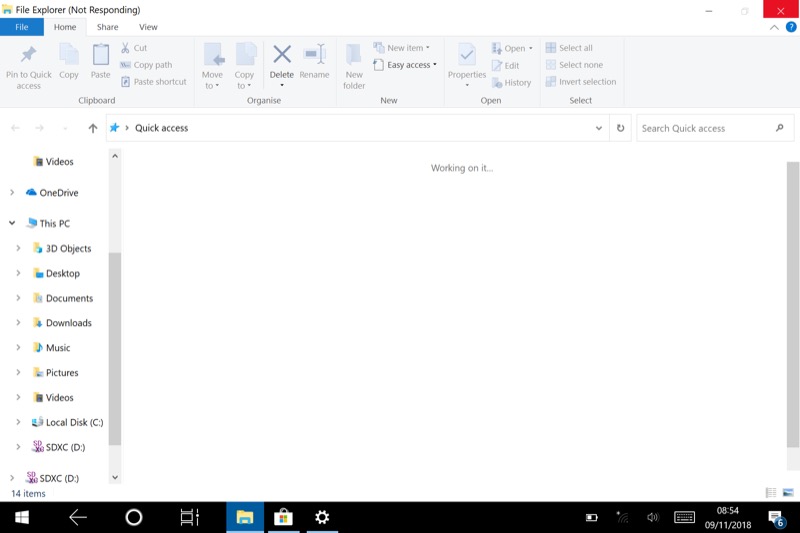
File Explorer is often unusable on the Surface Go. And I've no idea why... the rest of the PC carries on fine, with full SSD access, so it's clearly a bug in the Win32 code. And annoyingly, the UWP File Explorer doesn't seem available on the Surface Go, even via the Store. Very odd. And a little frustrating. A reboot fixes it, of course...
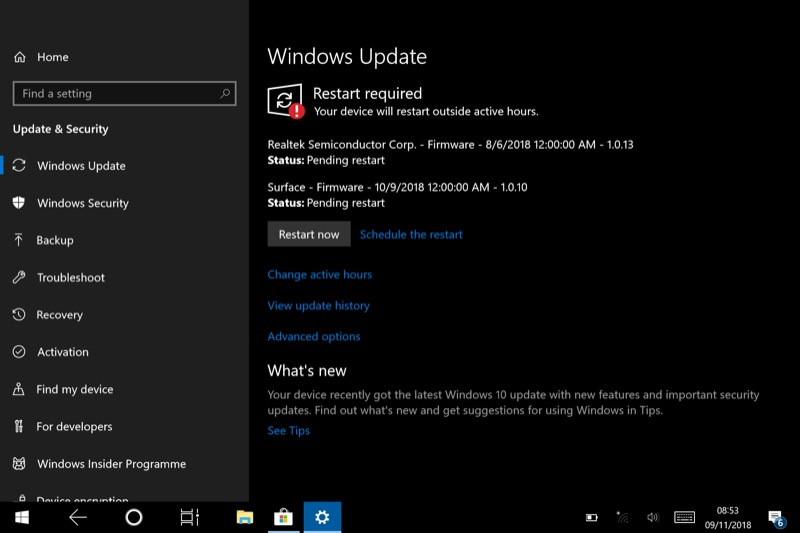
I was about to rant about Wi-fi being flaky on this review Surface Go - it lost all sight of its internal Wifi chip and I had to insert (via an adapter) an external Wifi transceiver to get things going again. And then a few hours later these firmware updates arrived and all has been well since. Phew!
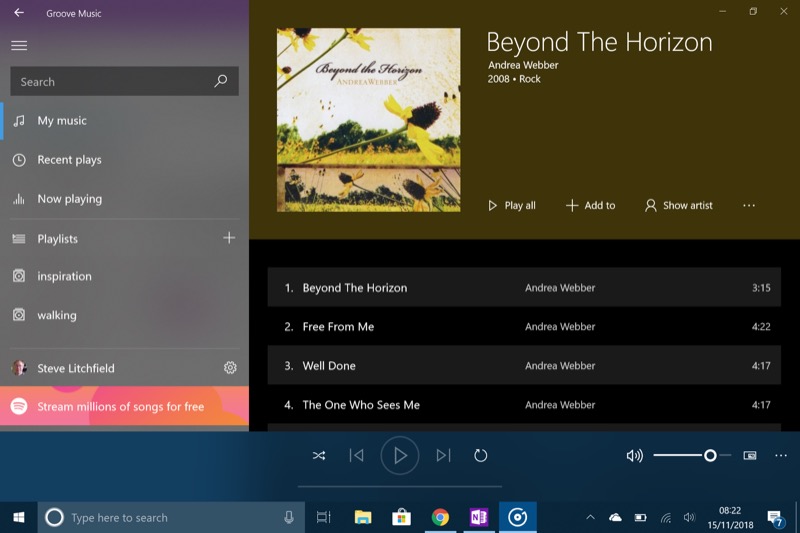
Groove Music may not have an online commercial service to tie into anymore, but it's a serviceable player for local and OneDrive content... in theory...
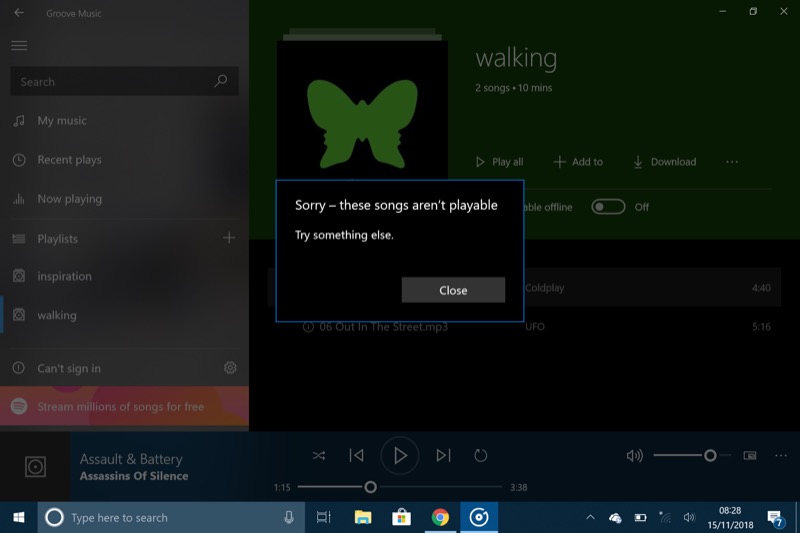
...but it has been more problematic on the Surface Go than on any other Windows computer I've used. More often than not, online streamed content was 'not playable'. A reboot always fixed it, but Groove Music UWP clearly needs some love and attention from Microsoft.
Onward and upward
So plenty to look forward to - the Surface Go feels just as much a PC as the larger Surface Pro devices before it, and as much as a traditional laptop. Performance hasn't been an issue overall, the only real restrictions have been having to use a (not supplied) USB-A to Type C adapter to connect anything, and in the physical screen size. I keep my Go set at "175%" for 'Display and layout' (the default is "150%"), which makes most of the Windows 'furniture' about right for my eyes. However, at this setting, some content management and development systems expecting a larger canvas mean that not everything was practical on the Go's display. But then the Surface Go isn't meant to replace your main workhorse PC/desktop, it's meant that you can get lots done on the go. Not 'everything', note, just 'lots'....

Not really the Go's fault, but with my preferred "175%" scaling, CMS like this give almost no working space for content! With the recommended scaling of "150%", you get the result below, looking much more normal - but it's all a bit small for my eyes on a 10" diagonal display!
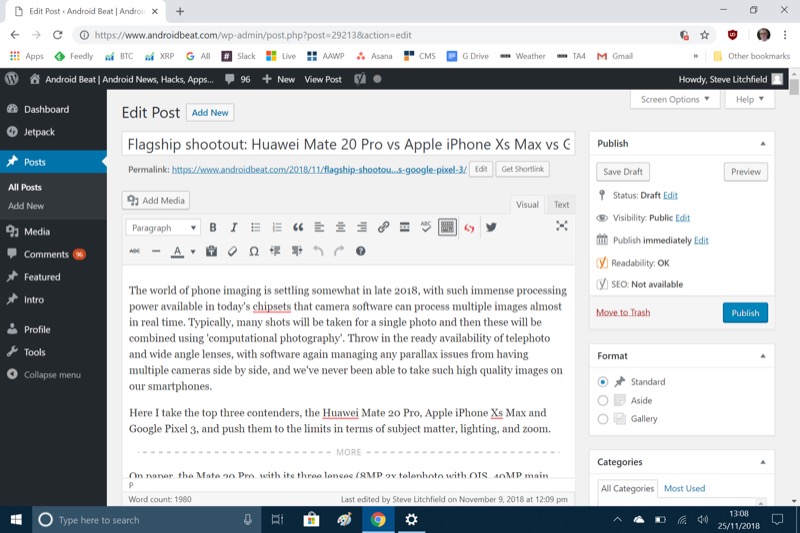
_________
In part 4 of this review, I'll cover the Surface Go's cameras - after all, this is a truly portable device, so why wouldn't you use its imaging, both standalone and in applications, when appropriate?
Reviewed by Steve Litchfield at
